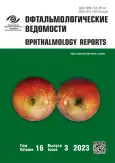Results of a survey of ophthalmologists on the special aspects in performing and interpreting optical coherence tomography examination of the macula
- Authors: Zaytseva O.V.1,2, Bobykin E.V.3, Krokhalev V.Y.3
-
Affiliations:
- Helmholtz National Medical Research Center of Eye Diseases
- A.I. Evdokimov Moscow State University of Medicine and Dentistry
- Ural State Medical University
- Issue: Vol 16, No 3 (2023)
- Pages: 71-81
- Section: In ophthalmology practitioners
- Submitted: 07.05.2023
- Accepted: 29.05.2023
- Published: 17.10.2023
- URL: https://journals.eco-vector.com/ov/article/view/397388
- DOI: https://doi.org/10.17816/OV397388
- ID: 397388
Cite item
Abstract
BACKGROUND: Optical coherence tomography (OCT) is the main method for in vivo examination of the morphology of ocular posterior segment structures, used in modern ophthalmological practice.
AIM: Study of special aspects in performing and interpreting the results of OCT of the macula by ophthalmologists working in the healthcare system of the Russian Federation.
MATERIALS AND METHODS: In the anonymous survey, conducted using an original online questionnaire of 12 questions 59 respondents took part. They confirmed being ophthalmologists with experience in performing OCT and gave their consent to took part in the survey.
RESULTS: The majority of respondents (79.6%) reported that they face the need to perform OCT without obtaining the patient’s clinical data. 66.1% of respondents always evaluate the correct placement of segmentation boundaries. Only 56% of the respondents always or often perform frontal (“en face”) scans during OCT examination of the macula. At the same time, 16.9% of specialists indicated that they did not know what “segmentation boundaries” are, and 8.5% noted that they did not understand the term “en face scan”. The principle of layer-by-layer analysis is used by 94.9% of respondents when describing images. Significant discrepancies were also revealed in the interpretation by the respondents of some parameters on specific examples of OCT scans. 71.2% of respondents have experience in using templates when describing OCT images, and 13.6% use them constantly. The proportion of specialists who consider it expedient to develop and introduce into clinical practice a standard protocol (template) for describing macular OCT images was 84.7%.
CONCLUSIONS: Insufficient awareness of some ophthalmologists about particular principles of interpreting the results of an OCT imaging and about certain practical aspects of its application was revealed. This indicates the need in improving the quality of informational support and training of specialists. A request was received from ophthalmologists about the need to develop a standard protocol (template) for describing OCT images of the macular area with the aim of subsequent implementation into the clinical practice of the healthcare system of the Russian Federation.
Full Text
About the authors
Olga V. Zaytseva
Helmholtz National Medical Research Center of Eye Diseases; A.I. Evdokimov Moscow State University of Medicine and Dentistry
Email: sea-zov@yandex.ru
ORCID iD: 0000-0003-4530-553X
SPIN-code: 5171-8473
Cand. Sci. (Med.), Associate Director, Leading Research Associate of the Department of Pathology of the Retina and Optic Nerve
Russian Federation, Moscow; MoscowEvgeny V. Bobykin
Ural State Medical University
Author for correspondence.
Email: oculist.ev@gmail.com
ORCID iD: 0000-0001-5752-8883
SPIN-code: 2705-1425
Scopus Author ID: 26430475300
Dr. Sci. (Med.), Assistant Professor; Assistant Professor of Ophthalmology Department
Russian Federation, YekaterinburgVadim Ya. Krokhalev
Ural State Medical University
Email: vkrokhalev@yandex.ru
ORCID iD: 0000-0003-1674-1957
SPIN-code: 1260-9768
Cand. Sci. (Geol.), Assistant Professor, Assistant Professor of the Department of Medical Physics and Digital Technologies
Russian Federation, YekaterinburgReferences
- Huang D, Swanson EA, Lin CP, et al. Optical coherence tomography. Science. 1991;254(5035):1178–1181. doi: 10.1126/science.1957169
- Bhende M, Shetty S, Parthasarathy MK, Ramya S. Optical coherence tomography: A guide to interpretation of common macular diseases. Indian J Ophthalmol. 2018;66(1):20–35. doi: 10.4103/ijo.IJO_902_17
- PubMed.gov [Internet]. National Library of Medicine [cited: 2023 Jan 29]. Available at: https://pubmed.ncbi.nlm.nih.gov/?term=optical%20coherence%20tomography%20macular&filter=simsearch1.fha&filter=simsearch3.fft&sort=pubdate&sort_order=asc&timeline=expanded
- avo-portal.ru [Internet]. Federal’nye klinicheskie rekomendatsii, odobrennye NPS Ministerstva zdravookhraneniya RF i utverzhdennye AVO [cited: 2023 Apr 5]. Available at: http://avo-portal.ru/doc/fkr/odobrennye-nps-i-utverzhdennye-avo (In Russ.)
- Lambrozo B, Rispoli M. OKT setchatki. Metod analiza i interpretatsii. Ed. by V.V. Neroev, O.V. Zaitseva. Moscow: Aprel’, 2012. 83 p. (In Russ.)
- Metrangolo C, Donati S, Mazzola M, et al. OCT Biomarkers in neovascular age-related macular degeneration: A narrative review. J Ophthalmol. 2021;2021:9994098. doi: 10.1155/2021/9994098
- Rahimy E, Freund KB, Larsen M, et al. Multilayered pigment epithelial detachment in neovascular age-related macular degeneration. Retina. 2014;34(7):1289–1295. doi: 10.1097/IAE.0000000000000130
- Browning DJ, Glassman AR, Aiello LP, et al. Optical coherence tomography measurements and analysis methods in optical coherence tomography studies of diabetic macular edema. Ophthalmology. 2008;115(8):1366–1371. doi: 10.1016/j.ophtha.2007.12.004
- Wolf-Schnurrbusch UEK, Ceklic L, Brinkmann CK, et al. Macular thickness measurements in healthy eyes using six different optical coherence tomography instruments. Invest Ophthalmol Vis Sci. 2009;50(7):3432–3437. doi: 10.1167/iovs.08-2970
- Folgar FA, Jaffe GJ, Ying GS, et al. Comparison of optical coherence tomography assessments in the comparison of age-related macular degeneration treatments trials. Ophthalmology. 2014;121(10):1956–1965. doi: 10.1016/j.ophtha.2014.04.020
- Toth CA, Tai V, Chiu SJ, et al. Linking OCT, angiographic, and photographic lesion components in neovascular age-related macular degeneration. Ophthalmol Retina. 2018;2(5):481–493. doi: 10.1016/j.oret.2017.09.016
- Querques G, Coscas F, Forte R, et al. Cystoid macular degeneration in exudative age-related macular degeneration. Am J Ophthalmol. 2011;152(1):100–107.e2. doi: 10.1016/j.ajo.2011.01.027
- Schmidt-Erfurth U, Waldstein SM. A paradigm shift in imaging biomarkers in neovascular age-related macular degeneration. Prog Retin Eye Res. 2016;50:1–24. doi: 10.1016/j.preteyeres.2015.07.007
- Giachetti Filho RG, Zacharias LC, Monteiro TV, et al. Prevalence of outer retinal tubulation in eyes with choroidal neovascularization. Int J Retina Vitreous. 2016;2:6. doi: 10.1186/s40942-016-0029-8
- Gombolevskii VA, Kharlamov KA, Pyatnitskii IA, et al editors. Shablony protokolov opisanii issledovanii po spetsial’nosti “Rentgenologiya”. Komp’yuternaya tomografiya. Moscow, 2016. 31 p. (In Russ.)
- Gombolevskii VA, Kharlamov KA, Pyatnitskii IA, et al editors. Shablony protokolov opisanii po spetsial’nosti “Rentgenologiya”. Magnitno-rezonansnaya tomografiya. Moscow, 2016. 40 p. (In Russ.)
- Shpak AA. Spektral’naya opticheskaya kogerentnaya tomografiya vysokogo razresheniya. Moscow: Atlas, 2014. 170 p. (In Russ.)
Supplementary files






















